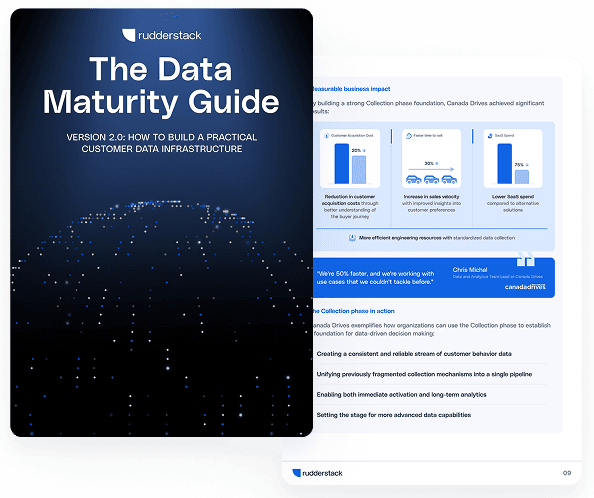Streaming data integration: Use cases and tools

Data doesn't wait. As clicks, transactions, and sensor readings happen across your systems, the value of that information fades by the second. But most data pipelines aren't designed to keep up—they process information on a delay, batch it into chunks, and make decisions after the moment has passed.
Streaming data integration changes that. It enables your systems to process and respond to events as they occur—whether you're adjusting pricing in real time, personalizing an experience mid-session, or detecting fraud before it completes.
This guide explores the principles and applications of streaming data integration—why it matters, how it works, and what it takes to make it reliable at scale.
Main takeaways:
- Streaming data integration enables real-time data collection, transformation, and delivery, supporting faster decision-making and operational agility
- Unlike batch processing, streaming pipelines reduce latency to seconds, making them ideal for use cases like personalization, fraud detection, and IoT monitoring
- Core components include ingestion from various sources, real-time transformation, and delivery to destinations like data warehouses or business tools
- Governance, schema validation, and observability are critical to maintaining secure, compliant, and reliable streaming data pipelines at scale
- Tools like Apache Flink, RudderStack Event Stream, and Debezium support scalable, low-latency streaming architectures across modern data stacks
What is streaming data integration?
Streaming data integration is the continuous collection, processing, and delivery of data from multiple sources in real time. Unlike batch processing, which handles data in large chunks at scheduled intervals, streaming integration processes each piece of data as it arrives.
This approach enables you to react immediately to new information without waiting for scheduled data transfers. Modern data stream technology connects your systems, applications, and databases to provide instant access to fresh insights.
The core components include data sources (where information originates), processing engines (that transform the data), and destinations (where data is delivered for use).
Streaming integration is essential when timely action matters, such as monitoring transactions, personalizing customer experiences, or detecting security threats.
Key differences from batch processing
Batch processing collects data over time and processes it all at once, often introducing delays of hours or days. Streaming integration handles each data point individually as it's generated.
Batch vs. streaming latency
The most significant difference is speed. Batch systems might update your dashboards nightly, while streaming integration delivers insights within seconds.
| Aspect | Batch processing | Streaming integration | Business impact |
|---|---|---|---|
| Latency | Hours or days | Seconds | Faster decisions |
| Resource usage | Periodic spikes | Consistent | Predictable costs |
| Use case fit | Historical analysis | Real-time action | Immediate response |
Impact on data strategy
Moving to streaming changes how your organization thinks about data. You'll need to design for continuous flow rather than scheduled jobs.
- Infrastructure needs: Systems that can process data 24/7
- Team skills: Familiarity with event-driven architecture
- Cost considerations: Ongoing resource usage versus periodic processing
Core building blocks of real-time data flow
A streaming data integration pipeline has three essential layers that work together to deliver real-time insights.
Ingestion layer
This component captures data as it's created from various sources:
- Web and mobile interactions
- IoT device readings
- Database changes
- Application logs
- Third-party API feeds
RudderStack Event Stream supports real-time data collection from web, mobile, and server sources with easy-to-implement SDKs.
Data transformation
Once collected, data often needs cleaning or enrichment before it's useful. Common transformations include:
- Filtering irrelevant events
- Standardizing formats
- Joining with reference data
- Masking sensitive information
RudderStack enables real-time transformations with code-first workflows that maintain data quality as information flows through your systems.
Destination layer
Processed data is delivered to where it creates value:
- Data warehouses for analytics
- Business applications for operations
- Dashboards for monitoring
- Notification systems for alerts
The real-time nature of streaming integration ensures all destinations have current information for decision-making.
Stream data from anywhere, instantly
See how RudderStack enables secure, real-time data streaming and integration at scale. Request a demo
Why businesses need continuous data integration
Whether you're scaling analytics or supporting AI initiatives, real-time data flow ensures decisions are powered by what's happening right now, not what happened yesterday.
Faster decision making
Real-time visibility lets you respond instantly to changing conditions, and 61% of organizations are evolving or rethinking their data and analytics operating model because of AI technologies, including:
- Financial services: Detect market shifts and adjust trading strategies
- E-commerce: Update inventory and pricing based on demand
- Manufacturing: Identify equipment issues before they cause downtime
Scalability and agility
Streaming integration architectures handle growing data volumes without redesigning your entire system. You can add new sources or destinations with minimal disruption, supporting innovation and rapid iteration.
The event-driven nature of these systems allows for horizontal scaling; simply add more processing nodes as volume increases. Modern streaming platforms like Apache Kafka and RudderStack provide abstraction layers that decouple producers from consumers, enabling teams to implement new data sources or analytics tools independently.
This modularity means engineering teams can deploy changes incrementally rather than requiring system-wide updates, reducing risk and accelerating time-to-value for data initiatives.
📊 Real-time investment is surging
61% of North American enterprises are investing in real-time analytics platforms, fueled by increased cloud adoption and the growing demand for AI-powered insights.
Practical use cases for streaming data integration
Streaming data powers numerous business applications across industries, enabling everything from real-time fraud detection in banking to dynamic inventory management in retail. Here are some practical use cases for streaming data integration:
1. Personalization
Real-time user data enables immediate personalization. When a customer browses your website, you can instantly update their profile and tailor content to their interests based on their current session behavior, past purchase history, and demographic information.
This real-time profiling allows you to dynamically adjust page layouts, product recommendations, and messaging within milliseconds of user actions, creating a more relevant and engaging experience that drives higher conversion rates.
- Product recommendations based on current browsing
- Dynamic pricing adjusted to demand
- Content customization reflecting user preferences
2. IoT and sensor monitoring
Data stream technology excels at handling continuous readings from thousands of devices simultaneously, processing millions of data points per second with minimal latency.
These systems can ingest, filter, and analyze sensor data in real time, enabling immediate detection of anomalies, predictive maintenance alerts, and operational optimizations across distributed device networks. Unlike batch systems, streaming platforms maintain continuous processing even when device counts scale into the millions.
- Manufacturing equipment monitoring
- Vehicle fleet tracking
- Environmental sensor networks
- Smart city infrastructure
3. Fraud detection and security
By analyzing transaction patterns, user behaviors, and system activities in real time, you can identify suspicious events within milliseconds of occurrence.
Machine learning algorithms can compare current actions against established baselines, flagging anomalies before fraud completes. This continuous monitoring enables security teams to implement automated countermeasures that block threats immediately rather than discovering breaches hours or days later:
- Unusual transaction patterns
- Unexpected login locations
- Abnormal system access
- Network traffic anomalies
4. Real-time analytics dashboards
Live dashboards help teams monitor operations without delay, providing continuous visibility into critical metrics and KPIs as they change.
These real-time interfaces transform raw data streams into actionable visualizations that enable immediate detection of trends, anomalies, and opportunities without waiting for scheduled reports. By presenting up-to-the-second information in an accessible format, teams can make informed decisions and respond to changing conditions as they unfold. These dashboards can include:
- Sales performance tracking
- Website traffic analysis
- Support queue management
- System health monitoring
Essential tools and frameworks for streaming data
Several technologies support streaming data workflows, each with specific strengths, and a benchmark clocked Apache Storm at over a million tuples processed per second per node.
Stream processing engines
These powerful engines process continuous data flows in real time, applying complex transformations, aggregations, and analytics to extract actionable insights as events occur. Top processing engines include:
- Apache Flink: Handles stateful processing with low latency
- Apache Spark Structured Streaming: Unifies batch and stream processing
- Materialize: Provides SQL interfaces for streaming data
- ksqlDB: Processes Kafka streams with SQL
- RisingWave: Simplifies streaming workflows
Change data capture
CDC tools continuously monitor database transaction logs to detect and capture modifications (inserts, updates, deletes) as they occur, transforming these changes into standardized event streams that can be processed in real-time without impacting database performance. This enables seamless integration of operational database changes with other data streams. Top tools include:
- Debezium: Open-source CDC for multiple databases
- RudderStack Event Stream + CDC: Unifies behavioral and database events
Streaming data delivery
These solutions efficiently route processed data streams to various downstream destinations, ensuring reliable delivery with exactly-once semantics and built-in error handling. Popular delivery tools include:
- RudderStack: Collects, transforms, and routes data to over 200 destinations
- Reverse ETL tools: Sync warehouse data to operational systems
Overcoming common data streaming challenges
Streaming architectures introduce specific challenges you'll need to address, including managing out-of-order events, handling backpressure when consumers can't keep pace with producers, ensuring exactly-once processing semantics, and maintaining state across distributed systems. Let's discuss those here.
Monitoring and observability
You need visibility into your pipelines to ensure reliability:
- Throughput: Events processed per second
- Latency: Time from generation to delivery
- Error rates: Failed events or dropped data
- Resource usage: CPU, memory, and network utilization
High throughput vs. low latency
Different use cases have different requirements, including:
- High throughput prioritizes volume (analytics, logging)
- Low latency prioritizes speed (real-time decisions, alerts)
Choose architectures and tools that match your specific needs rather than trying to optimize for everything.
Best practices for secure and compliant data pipelines
As data volumes and regulations increase, secure and compliant pipelines aren't optional; they're essential. The following practices help ensure your streaming data remains trustworthy, governed, and privacy-compliant from source to destination.
Governance and privacy controls
Strong governance ensures data flows are transparent, auditable, and respectful of user privacy.
- Data masking: Hide sensitive information during processing. This ensures teams can work with the data without exposing personally identifiable information (PII).
- Consent management: Track and enforce user permissions. This ensures your data usage aligns with user expectations and complies with privacy regulations like GDPR and CCPA.
- Audit trails: Log all data movements and transformations. These logs are crucial for internal accountability and external compliance audits.
Schema validation
Enforce data quality with schema validation:
- Reject malformed events
- Track schema changes over time
- Ensure compatibility with downstream systems
Catch bad data before it spreads
RudderStack’s built-in schema validation flags issues early, so your pipelines stay clean, compliant, and reliable.
How to evaluate the ROI of streaming initiatives
Measure the impact of your streaming data projects to justify investment. Here are the key metrics to evaluate:
Technical metrics
- Latency: Measures the time it takes for data to move from source to destination; lower latency means fresher insights and faster reactions.
- Throughput: Indicates how much data the system can handle in a given period, reflecting scalability and system capacity.
- Error rates: Tracks data loss, transformation failures, or system outages, helping you assess reliability and identify weak points in the pipeline.
Business metrics
- Time to insight: Captures how quickly decision-makers can act on data after it's generated—real-time pipelines should drastically reduce this lag.
- Customer satisfaction: Evaluates improvements in user experience (e.g., faster recommendations, reduced friction) due to real-time personalization or service updates.
- Revenue impact: Connects streaming use cases (e.g., personalized upsells, fraud detection) to tangible business outcomes like increased conversion or reduced loss.
Power real-time decisions with RudderStack's streaming infrastructure
Delayed data leads to missed opportunities. Streaming data integration lets your business act in the moment—whether that’s personalizing user experiences, catching fraud as it happens, or driving operational decisions with live signals.
RudderStack makes real-time integration easier. Our cloud-native infrastructure offers built-in schema validation, flexible stream processing, and privacy-first design to help you deliver trusted, low-latency data across your stack. From event collection to delivery, we take care of the plumbing so your team can focus on impact.
See how RudderStack can simplify your streaming strategy—request a demo today.
FAQs
What's the difference between streaming integration and event streaming?
Streaming integration focuses on connecting systems and moving data between them in real time, while event streaming specifically refers to capturing and processing individual events as they occur.
What types of businesses benefit most from streaming data integration?
Any organization that needs to make decisions based on current information benefits, including e-commerce companies tracking user behavior, financial services monitoring transactions, and manufacturers optimizing production.
How do I choose between batch and streaming for my data integration needs?
Consider your latency requirements, data volume, and use cases. Choose streaming when immediate insights matter, and batch when historical analysis on large datasets is the priority.
Published:
June 27, 2025

Data collection crossroads: When to use RudderStack or Google Tag Manager (or both)
In this post, we’ll review three options for how to implement RudderStack with Google Tag Manager, based on experience we’ve gathered across thousands of implementations.

Data integration framework: Components and best practices
A well-designed data integration framework can unify your data architecture, enabling automated pipelines, reducing inconsistencies, and providing a single source of truth for analytics and operations.

Webhook vs. API: What's the difference and when to use each?
Learn when to use APIs vs webhooks for customer data integrations. Compare pull vs push models, tradeoffs in latency, reliability, and control, and how combining both with RudderStack delivers real-time, flexible data flows.






